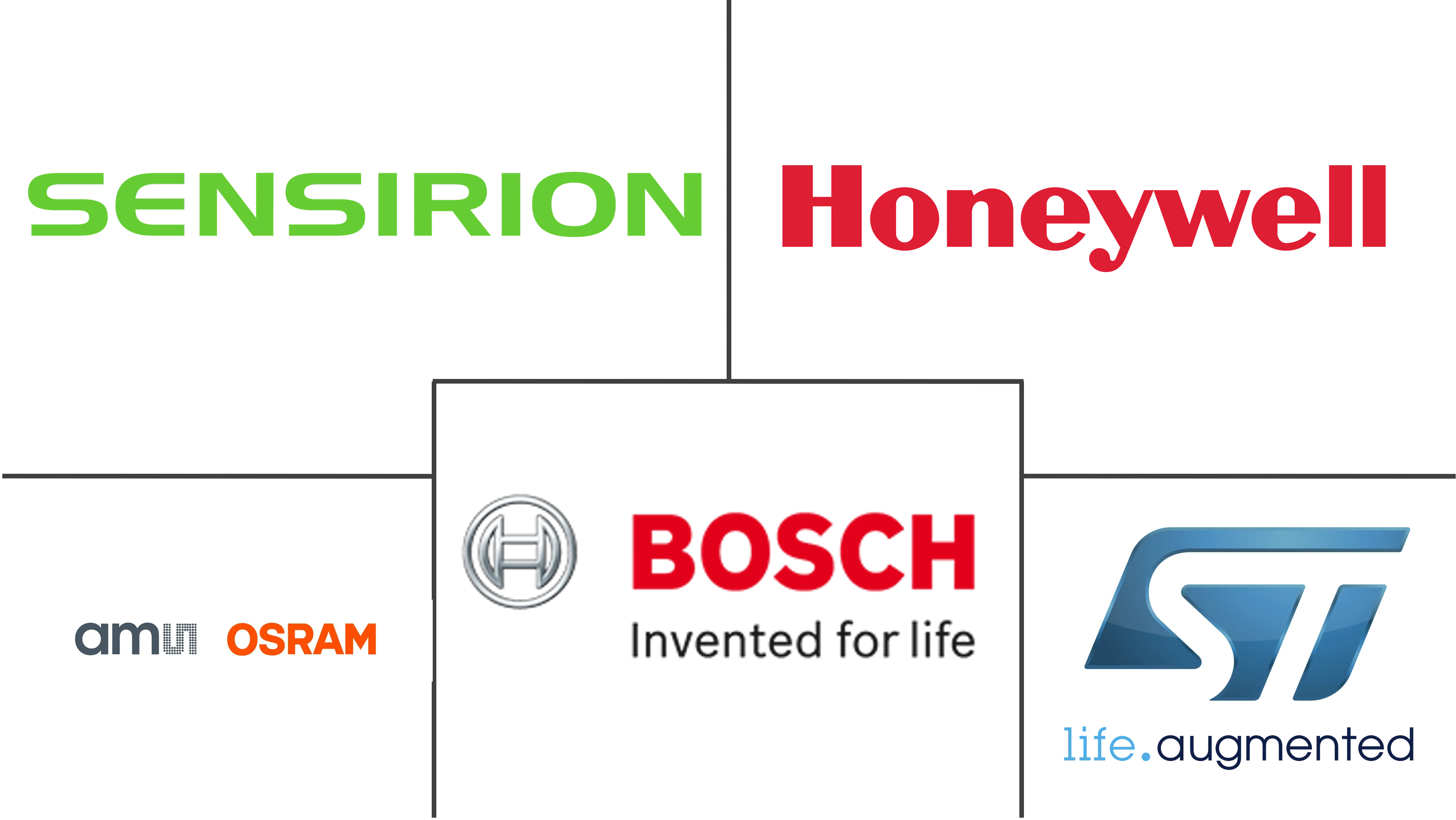Environmental Sensors Market Size and Share
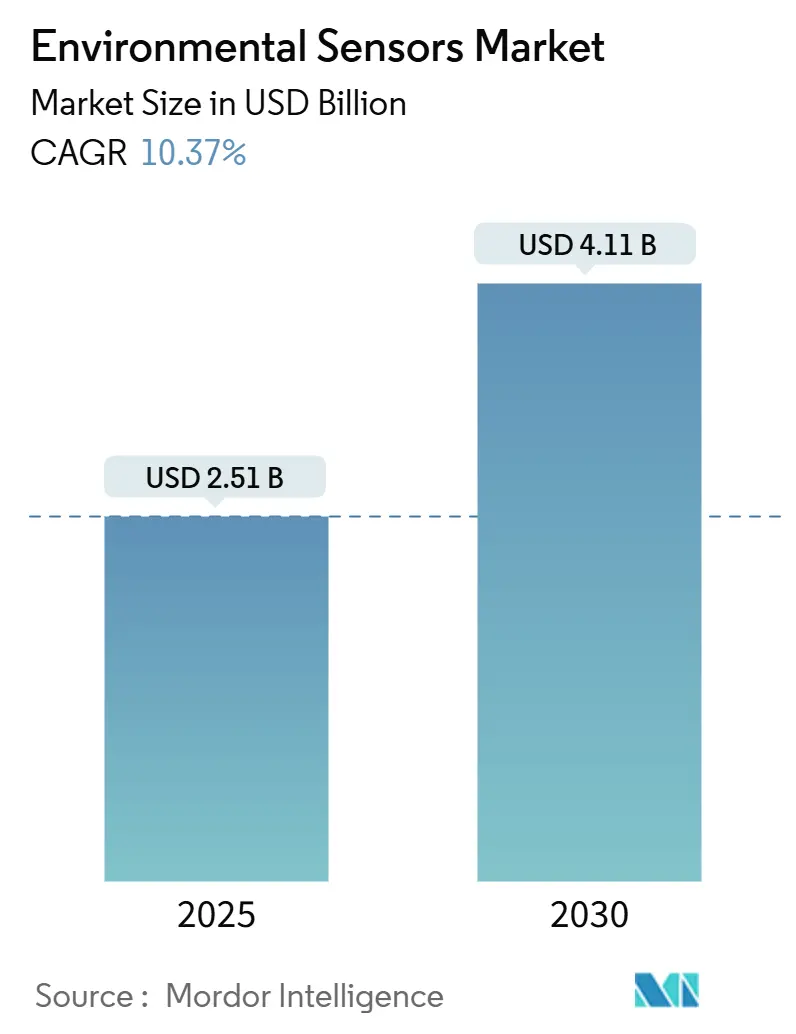
Environmental Sensors Market Analysis by Mordor Intelligence
The environmental sensors market was valued at USD 2.51 billion in 2025 and is forecast to grow at a 10.37% CAGR, reaching USD 4.11 billion by 2030. This robust outlook reflects intense regulatory pressure, rapid NB-IoT roll-outs, and widening adoption across smart cities, industrial IoT, and consumer wearables. Large accelerated filers in the United States must now disclose Scope 1 and Scope 2 greenhouse-gas emissions with third-party assurance, prompting accelerated sensor deployment for continuous monitoring. In Europe, the revised Ambient Air Quality Directive effective March 2025 forces member states to track ultrafine particles in real time, expanding demand for cost-effective sensor networks. Asia-Pacific leads the environmental sensors market thanks to Chinese NB-IoT infrastructure that supports high-density urban monitoring, while North America drives innovation in wildfire-detection networks and edge-AI platforms. Competitive intensity remains high as semiconductor majors, niche MEMS suppliers, and cloud-native IoT firms race to deliver resilient, cyber-secure, and self-calibrating solutions.
Key Report Takeaways
- By product type, fixed installations held 62% of the environmental sensors market share in 2024, whereas portable units are projected to expand at a 12.8% CAGR to 2030.
- By sensing type, gas sensors captured 26% revenue share in 2024; particulate matter sensors are forecast to grow at a 13.5% CAGR through 2030.
- By connectivity, wired solutions dominated with 55% share of the environmental sensors market size in 2024, while wireless nodes are poised for a 14.9% CAGR between 2025-2030.
- By end-user industry, industrial applications accounted for 24% of the environmental sensors market size in 2024; healthcare is advancing at a 14% CAGR during the same period.
- By geography, Asia-Pacific commanded 38% of the environmental sensors market share in 2024 and is expected to maintain leadership through 2030.
- Bosch Sensortec, Honeywell, and Texas Instruments together controlled nearly 21% of global revenue in 2024, anchoring a fragmented supplier landscape.
Global Environmental Sensors Market Trends and Insights
Drivers Impact Analysis
| DRIVER | (~) % IMPACT ON CAGR FORECAST | GEOGRAPHIC RELEVANCE | IMPACT TIMELINE |
|---|---|---|---|
| NB-IoT roll-outs enabling dense urban sensor grids | +1.8% | Asia-Pacific core, spill-over to MEA | Medium term (2-4 years) |
| Stricter EU Ambient Air Quality Directive thresholds | +1.5% | Europe; reference for North America compliance | Short term (≤ 2 years) |
| ESG-linked Scope 1 & 2 disclosure mandates | +2.1% | North America & EU, cascading globally | Short term (≤ 2 years) |
| Multi-parameter modules in wearables & hearables | +1.2% | Global; strongest in developed markets | Medium term (2-4 years) |
| Sensors for green-hydrogen and battery gigafactories | +0.9% | Europe, North America, China | Long term (≥ 4 years) |
| Wildfire early-warning networks in North America | +0.7% | North America; preview for Australia | Short term (≤ 2 years) |
| Source: Mordor Intelligence | |||
Increased NB-IoT Deployments Enabling Dense Urban Sensor Networks (Asia)
Chinese operators now run more than 900 million NB-IoT connections, and expansion plans aim for 1.9 billion by 2030, giving cities like Shenzhen the backbone for block-level air-quality mapping. The low-power wide-area standard supports decade-long battery life, deep-indoor penetration, and licensed-spectrum reliability, letting municipalities blanket high-rise districts without trenching cables. Neighboring economies from Thailand to the UAE mirror this model to accelerate smart-city roll-outs and ESG compliance.[1]RCR Wireless News, “NB-IoT and LoRa crowned kings of IoT – to hit 3.5bn connections by 2030,” rcrwireless.com
Tightening EU Ambient Air-Quality Directive 2023/2119 Standards
The March 2025 directive slices the annual PM2.5 limit from 25 µg/m³ to 10 µg/m³ and mandates ultrafine particle tracking, forcing member states to supplement costly reference stations with dense sensor clusters. Real-time public-data access clauses privilege IoT-ready modules that stream measurements to central dashboards, spurring demand for calibrated MEMS units capable of ±5 µg/m³ accuracy in urban smog.
ESG-Linked Industrial Emissions Disclosure Mandates (SEC, CSRD)
SEC rules effective May 2024 and the EU’s CSRD oblige thousands of issuers to file granular, assurance-verified emission data, moving environmental sensors from discretionary OpEx to compliance essential. Companies retrofit flue-gas stacks, boiler rooms, and fugitive-leak zones with continuous monitoring systems, boosting orders for electrochemical and NDIR gas analyzers qualified for audit-grade reporting.
Adoption of Multi-parameter Sensor Modules in Wearables & Hearables
Bosch Sensortec’s 4.2 × 3.5 × 3 mm BMV080 PM sensor shows that air-quality tracking can hide inside earbuds and smartwatches without battery-life penalties. In-ear positioning enhances signal-to-noise ratios for respiratory metrics, letting consumer brands market personalized exposure insights to allergy and asthma sufferers.[2]Bosch Sensortec, “Bosch particulate matter sensor BMV080,” bosch-sensortec.com
Restraints Impact Analysis
| RESTRAINTS | (~) % IMPACT ON CAGR FORECAST | GEOGRAPHIC RELEVANCE | IMPACT TIMELINE |
|---|---|---|---|
| Calibration drift & high maintenance in harsh climates | −1.4% | Global; acute in deserts & tropics | Medium term (2-4 years) |
| Scarce reference-grade calibration sites in emerging markets | −1.1% | MEA, Latin America, parts of Asia-Pacific | Long term (≥ 4 years) |
| Cyber-security risks in cloud-connected industrial nodes | −0.8% | Global; critical infrastructure hubs | Short term (≤ 2 years) |
| Price erosion from MEMS commoditization | −0.6% | Global; led by Asia-Pacific fabs | Medium term (2-4 years) |
| Source: Mordor Intelligence | |||
Calibration Drift & Maintenance Costs in Harsh Outdoor Environments
Electrochemical sensors deployed in outdoor environments experience significant calibration drift due to temperature fluctuations, humidity variations, and exposure to interfering gases, requiring recalibration intervals as frequent as every 3 months to maintain acceptable accuracy. This maintenance burden creates substantial operational costs that can exceed initial sensor procurement costs within the first year of deployment, particularly in harsh climates where environmental stressors accelerate sensor degradation. Research indicates that over 90% of sensors remain within calibration specifications during routine checks, suggesting that current maintenance schedules are overly conservative but necessary due to the high cost of compliance failures.
Limited Reference-Grade Calibration Infrastructure in Emerging Economies
Emerging economies lack the reference-grade monitoring infrastructure necessary to calibrate low-cost sensor networks, creating a fundamental barrier to accurate environmental monitoring in regions where such data is most critically needed for public health protection. Studies in Kenya and Ghana demonstrate that while low-cost sensors can provide valuable trend information, the absence of nearby reference stations limits their ability to provide quantitative measurements suitable for regulatory compliance or health risk assessment. The spatial mismatch between PM2.5 pollution hotspots and available calibration infrastructure is particularly pronounced in Sub-Saharan Africa and Southeast Asia, where rapid urbanization creates new pollution sources faster than monitoring infrastructure can be established.
Segment Analysis
By Product Type: Fixed Installations Anchor Compliance Budgets
Fixed installations dominated the environmental sensors market size with 62% revenue in 2024, reflecting plant operators’ need for uninterrupted proof of regulatory conformity. These wall-mounted or duct-inserted probes feed 24/7 data to environmental management systems that auditors rely on for Scope 1 verification. Portable devices, although smaller in volume, are pacing a 12.8% CAGR through 2030 as first-responders, mining firms, and construction consortia favor rapid deployment along shifting work sites. The Department of Homeland Security’s wildfire pilot showed that trailer-mounted PM nodes delivered 30-minute lead times over satellite imagery, validating the business case for mobile grids.
Portables increasingly complement—not replace—fixed arrays. Utilities, for instance, install hard-wired SO₂ stacks for compliance, then wheel battery-powered VOC sniffers during maintenance outages. Wearable units remain nascent but give consumer OEMs a route to health-centric differentiation, bundling pollen counts or pollution alerts into fitness dashboards. Over the forecast cycle, hybrid architectures blending permanent baselines with redeployable clusters will redefine procurement guidelines across the environmental sensors market.

Note: Segment shares of all individual segments available upon report purchase
By Sensing Type: Gas Detection Retains Lead, Particulate Modules Surge
Gas analyzers captured 26% of environmental sensors market share in 2024 thanks to mature electrochemical cells and NDIR optics that detect CO, NOₓ, and volatile organic compounds in factories, tunnels, and boilers. Particulate-matter devices, however, are charting a 13.5% CAGR as public-health agencies tighten PM2.5 exposure thresholds. Environmental sensors market size for PM instruments is forecast to reach USD 1.01 billion by 2030, buoyed by EU and California mandates demanding 10 µg/m³ annual averages.
Temperature, humidity, and pressure chips remain ubiquitous housekeeping parameters, often bundled with primary gas or PM functions inside multi-parameter modules. Bosch Sensortec’s BME688 unites four physical sensors plus on-board AI inference, slicing bill-of-materials cost by 20% for OEMs that previously bought discrete components. Convergence blurs historical category lines, steering purchasing toward holistic “environment packs” rather than single-parameter parts.
By Connectivity: Wireless Nodes Redefine Total Cost of Ownership
Wired links—RS-485, 4-20 mA, and Ethernet—secured 55% revenue in 2024 as petrochemical and power stations trust deterministic protocols immune to RF interference. Yet wireless shipments will grow at 14.9% CAGR, narrowing the share gap by 2030. Each wireless node trims install cost by up to 80% when dozens of probes pepper a refinery flare field. NB-IoT in China and LTE-Cat-M in Europe form the backbone, while LoRaWAN and 5G private networks serve rural grids.
Edge AI further tilts economics: Texas Instruments’ 2024 MCU with an embedded neural engine lets a PM sensor classify smoke on-chip, pushing only alarms to the cloud and saving 90% uplink bandwidth. As firmware-defined features propagate, the line between connectivity and computing blurs, steering buyers toward intelligent, self-healing architectures.[3]Texas Instruments, “New TI MCUs enable edge AI and industry-leading real-time control,” ti.com
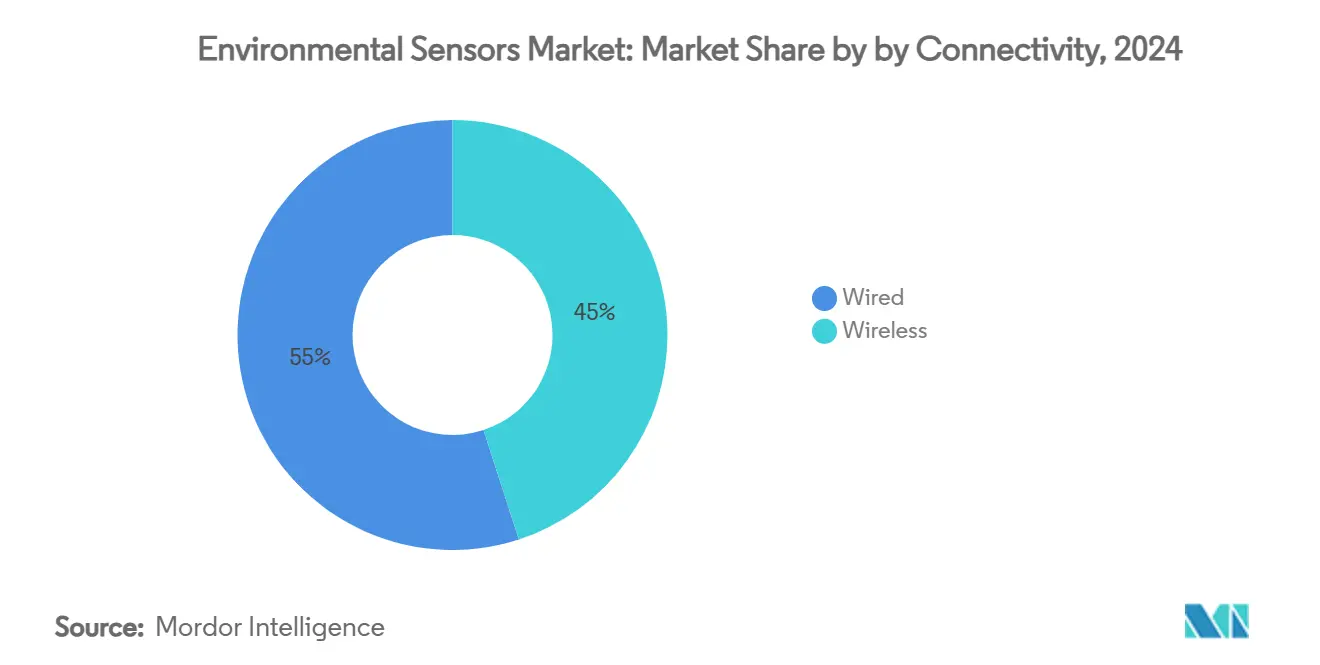
By End-User Industry: Industrial Facilities Dominate, Healthcare Emerges
Industrial sites held 24% of environmental sensors market size in 2024, driven by continuous-emission monitoring for stacks, fugitive-gas hubs, and wastewater vents. The SEC rule and EU CSRD elevate sensor budgets from optional OpEx to board-level compliance safeguards. Healthcare climbs fastest at 14% CAGR as hospitals integrate PM and CO₂ feedback into HVAC automation to curb nosocomial infections. Smart ventilators and inhalers add ambient data to refine therapy algorithms.
Consumer electronics remain volume drivers—smartphones now embed barometers and temperature sensors as standard—but average selling prices are a fraction of industrial units. Automotive OEMs equip electric vehicles with cabin air-quality modules to comply with China’s GB/T 27630 interior-air standard, while autonomous-vehicle prototypes seek ambient visibility for perception stacks. Agriculture, though smaller, shows promise through precision-farming roll-outs that cut water use 20% using soil-moisture telemetry.
Geography Analysis
Asia-Pacific led the environmental sensors market with 38% revenue in 2024, powered by smart-city mega-projects in China and India that embed NB-IoT nodes in streetlights, buses, and schools. Shenzhen alone operates more than 37,000 air-quality boxes feeding open data portals. Strong electronics supply chains lower bill-of-materials, letting municipalities deploy square-kilometer grids for less than USD 15,000. Japanese and South Korean fabs inject advanced MEMS capacity, while Australian states invest in PM-and-smoke arrays for bushfire response.
North America ranks second by value. The environmental sensors market here gains momentum from SEC climate disclosure obligations and wildfire-defense funding across California, Oregon, and British Columbia. Cloud-edge alliances flourish: Honeywell’s 2024 pact with Analog Devices links building-automation gateways directly to Azure IoT hubs, cutting integration times by half. Federal grants under the CHIPS and Science Act funnel R&D toward cyber-resilient sensor firmware.
Europe remains pivotal; tightened PM2.5 and ultrafine norms drive sensor retrofits across 400+ cities. Germany ties environmental telemetry to Industry 4.0 digital twins, while Nordic utilities install dew-point arrays inside district-heating vaults to manage condensation energy losses. Implementation lead times shorten because EU funds now reimburse up to 75% of air-quality network costs under Horizon Europe.
The Middle East and Africa presently represent a single-digit share but exhibit 14.2% CAGR. Gulf petro-states adopt continuous-leak detection for ESG-linked bond issuance, and South Africa’s mining sector pilots low-cost PM nets to bolster labor-safety audits. Scarce calibration labs remain a hurdle, but donor-funded reference stations scheduled for 2026-2027 will unlock volume orders across Nairobi, Accra, and Lagos.
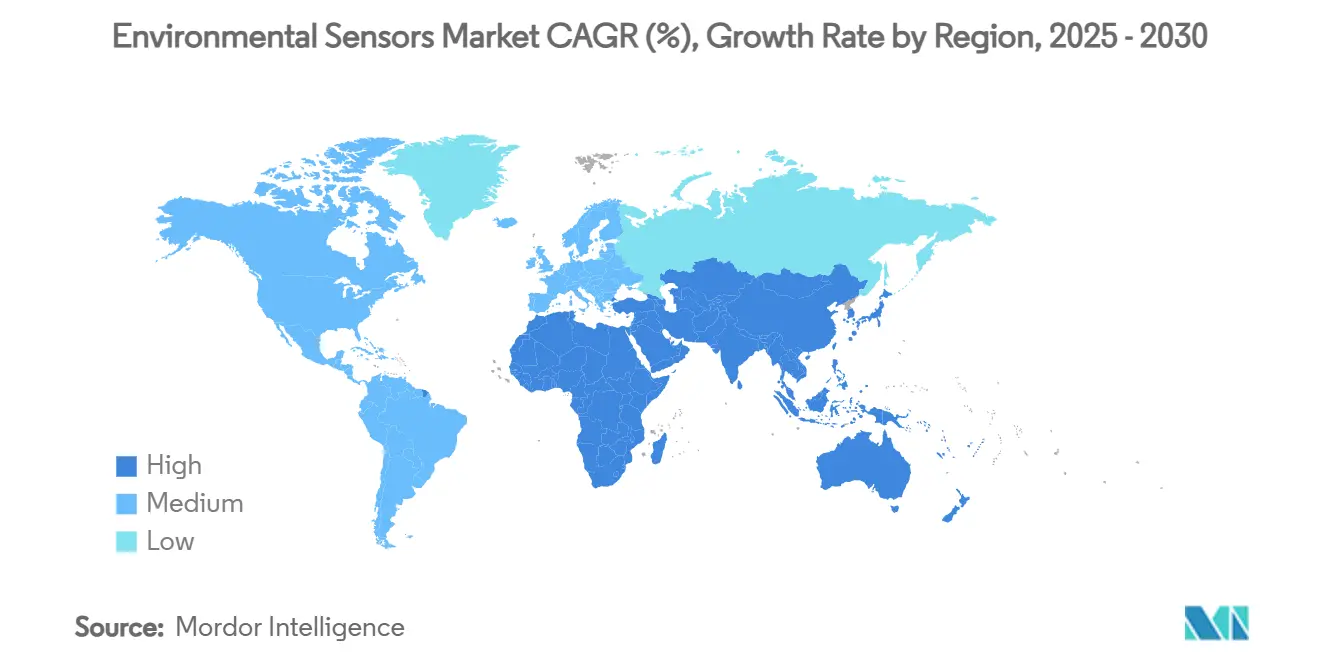
Competitive Landscape
The environmental sensors market features a Herfindahl-Hirschman Index below 1,000, signaling fragmentation. Bosch Sensortec, Honeywell, and Texas Instruments together controlled roughly 21% revenue in 2024, while more than 60 suppliers split the remainder. Incumbents leverage captive fabs and IP portfolios—Bosch’s BME688 integrates four sensors plus AI firmware—to defend margins. Niche firms such as Sensirion and Figaro Engineering win design-ins by offering sub-1 ppm gas accuracy and rapid customer support.
Strategic alliances proliferate: STMicroelectronics and Qualcomm’s October 2024 collaboration bundles STM32 MCUs with Qualcomm’s RF front-ends to fast-track wireless sensor modules. Vertical mergers loom as cloud providers eye data-rich endpoints—AWS’s 2025 minority stake in a European PM-sensor startup signals data-platform convergence. Cyber-security compliance (FIPS 140-3, IEC 62443) emerges as a procurement filter; vendors lacking secure-element roadmaps risk disqualification from energy-utility tenders.
Cost pressure rises with Chinese OEMs flooding mid-tier markets at 30% lower ASPs, prompting Western suppliers to differentiate on firmware-upgradable analytics and 10-year stability guarantees. Edge-AI libraries that classify odor or smoke unlock SaaS-like recurring revenue, shifting focus from hardware gross margin to lifetime-service contracts. Over the forecast period, expect selective consolidation as cash-rich conglomerates scoop specialist IP, tightening the supplier roster without tipping into oligopoly.
Environmental Sensors Industry Leaders
-
ams OSRAM AG
-
Sensirion Holding AG
-
Bosch Sensortec GmbH
-
Honeywell International Inc.
-
STMicroelectronics N.V.
- *Disclaimer: Major Players sorted in no particular order
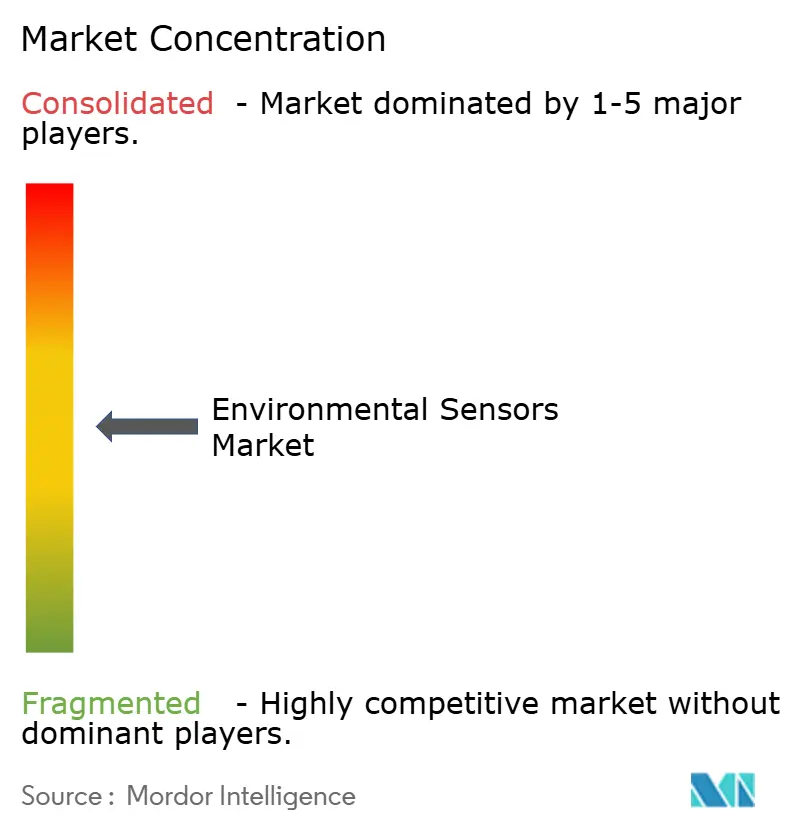
Recent Industry Developments
- June 2025: University of São Paulo researchers developed drone-mounted gas sensors with AI capabilities for forest fire detection and greenhouse gas monitoring, demonstrating more efficient and cost-effective GHG monitoring compared to satellite-based methods. The technology enables volumetric data collection on gas distribution patterns not possible with current satellite monitoring approaches.
- May 2025: Santa Clara County approved deployment of AI-equipped smoke sensors for wildfire early detection, following similar implementations in Oakland, Palo Alto, and Stanford University, with sensors capable of detecting smoke from up to 4 miles away at costs between USD 5,000 and USD 7,000 each. The county allocated USD 210,000 to USD 260,000 for 30 sensor installations.
- April 2025: Bosch Sensortec launched the BME688 AI-enabled gas sensor featuring machine learning capabilities for detecting fire gases and volatile organic compounds, with applications in wildfire prevention and indoor air quality monitoring. The sensor integrates gas, humidity, temperature, and pressure sensing with on-device AI processing.
- March 2025: The EU's revised Ambient Air Quality Directive became effective, mandating ultrafine particle monitoring and reducing annual PM2.5 limits from 25 μg/m³ to 10 μg/m³ across member states. The directive requires expanded monitoring networks beyond traditional reference stations.
Global Environmental Sensors Market Report Scope
Environmental sensors are critical for making a more connected world possible. From providing information on the immediate surroundings to help tackle global climate change, sensors and sensor networks have been fundamentally changing awareness of the detrimental factors that affect the environment. The market study categorizes the analysis of the environmental sensors manufactured and provided by various vendors in different regions. The study categorizes environmental sensors by product type, sensing type, end-user vertical, and geography.
The Environmental Sensors Market is Segmented by Product Type (Fixed, Portable), Sensing Type (Humidity, Temperature, Gas, Pressure), End-user (Medical, Consumer Electronics, Industrial, and Automotive), and Geography. The market sizes and forecasts are provided in terms of value (USD million) for all the above segments.
| Fixed |
| Portable |
| Wearable |
| Gas |
| Temperature |
| Humidity |
| Pressure |
| Particulate Matter (PM) |
| Multi-parameter Modules |
| Wired |
| Wireless |
| Industrial |
| Medical and Healthcare |
| Consumer Electronics |
| Automotive |
| Smart Homes and Buildings |
| Agriculture |
| Other End-Users |
| North America | United States |
| Canada | |
| Mexico | |
| Europe | United Kingdom |
| Germany | |
| France | |
| Italy | |
| Rest of Europe | |
| Asia-Pacific | China |
| Japan | |
| India | |
| South Korea | |
| Rest of Asia-Pacific | |
| Middle East | Israel |
| Saudi Arabia | |
| United Arab Emirates | |
| Turkey | |
| Rest of Middle East | |
| Africa | South Africa |
| Egypt | |
| Rest of Africa | |
| South America | Brazil |
| Argentina | |
| Rest of South America |
| By Product Type | Fixed | |
| Portable | ||
| Wearable | ||
| By Sensing Type | Gas | |
| Temperature | ||
| Humidity | ||
| Pressure | ||
| Particulate Matter (PM) | ||
| Multi-parameter Modules | ||
| By Connectivity | Wired | |
| Wireless | ||
| By End-User Industry | Industrial | |
| Medical and Healthcare | ||
| Consumer Electronics | ||
| Automotive | ||
| Smart Homes and Buildings | ||
| Agriculture | ||
| Other End-Users | ||
| By Geography | North America | United States |
| Canada | ||
| Mexico | ||
| Europe | United Kingdom | |
| Germany | ||
| France | ||
| Italy | ||
| Rest of Europe | ||
| Asia-Pacific | China | |
| Japan | ||
| India | ||
| South Korea | ||
| Rest of Asia-Pacific | ||
| Middle East | Israel | |
| Saudi Arabia | ||
| United Arab Emirates | ||
| Turkey | ||
| Rest of Middle East | ||
| Africa | South Africa | |
| Egypt | ||
| Rest of Africa | ||
| South America | Brazil | |
| Argentina | ||
| Rest of South America | ||
Key Questions Answered in the Report
What is the current size of the environmental sensors market?
The environmental sensors market stood at USD 2.51 billion in 2025 and is projected to reach USD 4.11 billion by 2030.
Which region leads global demand for environmental sensors?
Asia-Pacific holds 38% of global revenue thanks to large-scale NB-IoT deployments and government-funded smart-city programs.
Why are particulate matter sensors growing faster than gas sensors?
Stricter PM2.5 limits in Europe and wildfire smoke concerns in North America push municipalities and consumers to install high-density PM monitoring networks, driving a 13.5% CAGR for these devices.
How will SEC climate rules affect industrial sensor purchases?
From 2024 forward, large U.S. filers must report assured emissions data, making continuous sensors a mandatory part of compliance budgets rather than discretionary spend.
What connectivity technologies dominate upcoming sensor roll-outs?
While wired links remain critical in heavy industry, wireless nodes using NB-IoT, LTE-Cat-M, LoRaWAN, and emerging 5G private networks will grow nearly 15% annually thanks to lower installation costs and edge-AI capabilities.
Which companies are at the forefront of AI-enabled environmental sensing?
Bosch Sensortec, Texas Instruments, and STMicroelectronics lead in integrating neural inference cores directly on sensor or MCU silicon, enabling real-time pattern recognition and self-calibration at the edge.
Page last updated on:
